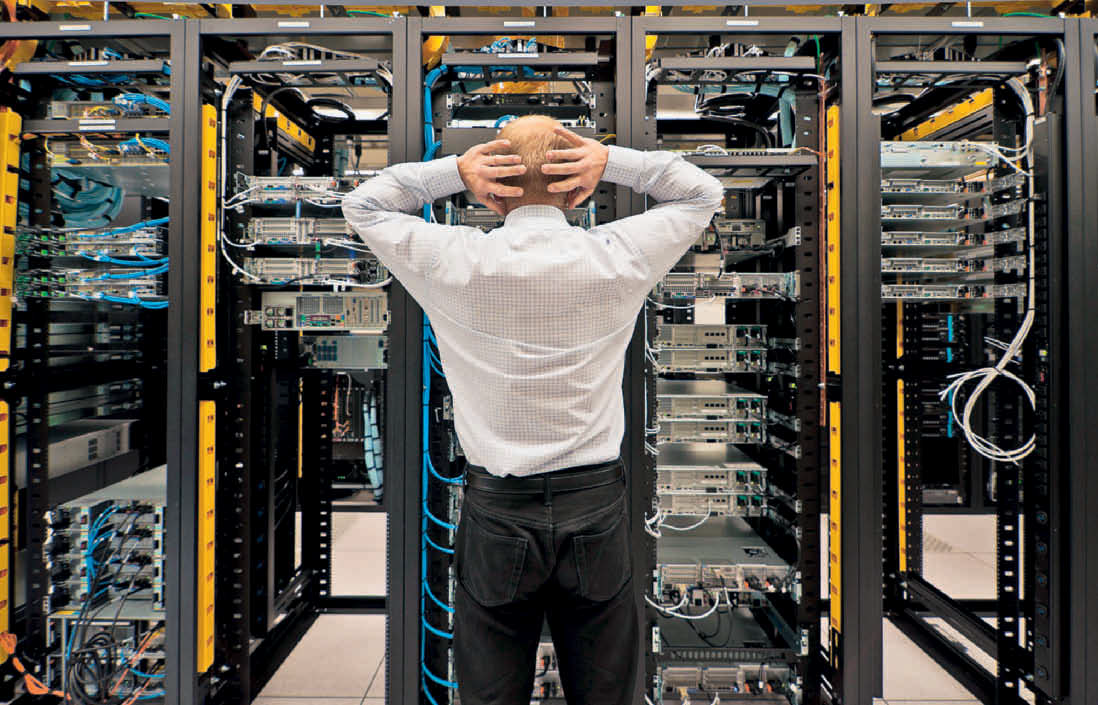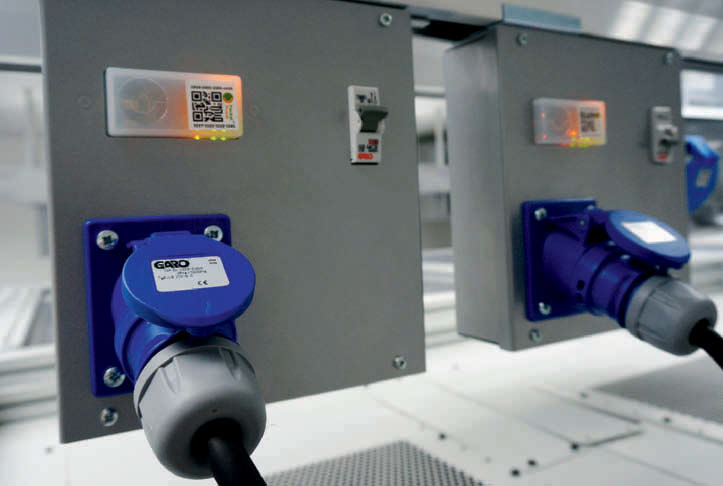Solutions for monitoring power and environmental parameters in data centers
Because, as we all know, you can only improve what you can measure, the market for solutions for monitoring power and environmental parameters in data centers is booming - and rightly so, because the measurement tools are proving to be versatile, offering users numerous functional advantages and a high level of benefit.

As a routine task, they collect and log vital data on power usage and environmental conditions, make it available to data center and facility specialists for analysis purposes, and warn of critical values. On the one hand, the early detection of problematic temperature values or a fluctuating power supply can prevent system malfunctions or downtime. On the other hand, the systems not only fulfill the role of an early warning system for corresponding risks, but also help to detect energy or thermal weak points in a data center environment. In this way, monitoring solutions provide the key data needed to analyze and ultimately optimize the use of resources by IT equipment and the surrounding infrastructure. Ultimately, in addition to improved capacity utilization, they can also contribute to significant energy savings and correspondingly lower CO2 emissions and all the associated economic and ecological benefits. And these are far from insignificant, considering that electricity is one of the fastest growing cost factors in the data center. In the study "Energy Consumption and Energy Costs of Servers and Data Centers in Germany: Current Trends and Savings Potentials until 2015". the Borderstep Institute puts the annual increase in electricity costs since 2005 at an average of five percent. Due to the further effects of the energy transition and steadily climbing electricity prices, the rate of increase will be much higher in the coming years.
In view of these numerous and valid arguments in favor of power and environment monitoring, the question for data center decision-makers is usually not whether they should deploy such a system today or in the near future, but rather which one is best suited to meet individual current and also future requirements.
What are the solutions?
The forms of power and environmental monitoring and the solutions offered for them are diverse. In their basic structure, they usually consist of a hardware-, software- or web-based management system and measurement or sensor modules that perform their measurement activities either as stand-alone units or integrated into PDU power strips, for example. Depending on the requirements and the choice of solution, a selective, networked or close-meshed monitoring structure can be set up in data center environments. Conventionally, the monitoring modules forward the collected power and environmental data to a proprietary management platform via a serial connection or a bus system. There, the data is read, logged and converted and can then be integrated into an overall data center management system via SNMP, Modbus, BACnet or other protocols. A solution called Packet Power, which handles communication between the sensor and measurement modules and data transfer to an SNMP or Modbus gateway completely wirelessly and by radio, occupies a special position. Since it differs from the majority of solutions on the market, its mode of operation and properties are explained below and contrasted with those of conventional monitoring technologies.

Wireless technology has long been socially acceptable
Before we really get into the subject, we should take the wind out of the sails of the "wireless technology has nothing to do in the data center" faction, which, although small, can still be heard in isolated cases: In some cases, their concerns, which were mostly nurtured in the past, related to compatibility with other IT equipment or were expressed as general concerns about security. This is countered by the fact that today's wireless technologies with, for example, 863 to 868 MHz, 902 to 927 MHz, 2.4 GHz or RFID use communication paths, frequencies and protocols that are country- and demand-specific or optimized specifically for data center monitoring. In the specific case, according to manufacturer Packet Power, all communications are tap-proof, distributed over packets and fully encrypted as required. The technology can coexist well with other radio services in the building, has high immunity to interference and uses dynamic frequency bands where there is no interference with other equipment in the data center. Additional security features and protections are discussed further below.
Radio vs cable
In the radio-based monitoring solution, the module for measuring the power parameters is integrated directly into the power cable. This simply replaces the conventional power cables with which IT devices and components are equipped out of the box. Common supply cables, PDUs and outgoing feeder boxes for 110 to 240 VAC and 16, 32 or 63 amps can be converted accordingly. Integration of the measuring devices in feeder boxes and distribution boards for single-phase or three-phase current from 10 to 2000 amperes is also supported. The acquisition of current values, such as volts, amps, watts, current consumption, frequency, power factor, apparent power or consumption peaks, can be broken down from the spatial distribution level down to individual devices. Power monitoring is thus more granular than when the equipment is monitored grouped via PDU plug-in strips or combined as a large distribution unit per rack, as is the case with other solutions.
Installation and setup
Probably the most striking difference to conventional solutions is experienced by data center or facility specialists during implementation of the wireless system: After the units for environmental monitoring have been placed and activated and the power cables with the integrated measuring modules have been connected, they automatically begin to configure themselves, start their measuring activities and exchange their data in the wireless network. The cabling and configuration effort that is usual with other monitoring solutions is thus eliminated.
The measurement data of the wireless solution is collected centrally at a gateway and transmitted via SNMP or Modbus either to a dedicated user interface as software, web or cloud application or to existing data center or building management applications. The system's own management tool prepares the measurement data into actual and trend reports on power usage at the building, room, distribution, rack or device level and on environmental parameters for each room, per rack row, rack or even for the different levels and heights in a single cabinet, and displays them graphically. Using dashboard displays or in tabular form, it is possible, for example, to read the consumption values for each IT device, the utilization of distributions and individual outlets, as well as temperature, pressure and humidity values at the racks, electricity costs and CO2 emissions. Like the management platforms of other monitoring systems, it allows the predefinition of thresholds for critical power and environmental values, so that if they are exceeded, automatic alerts are triggered via SNMP or e-mail.
Extensions and capacities
If extensions are required, the new environmental or current measurement module is simply placed at the desired location or connected to a distribution system integrated in the power cable or feeder box. The remaining steps, as already described, are self-configuring and almost fully automatic. An SME version of the gateway converts and transfers the data from up to 250 monitoring modules. The enterprise version handles up to 2000 units and more via multiple gateways. By setting up additional gateway instances, the number of sensor and measurement modules can theoretically be increased without limit. Existing third-party monitoring modules can be integrated into the management system, provided they communicate via TXT, HTML, CSV, XML, SNMP or Modbus over TCP.
Redundancy and security
As with cable-based monitoring systems, the transmitted measurement data is logged and stored with a time stamp via a management tool so that it remains available at all times. The transfer of measurement data can be encrypted for the wireless system just as for cable- or IP-based solutions. In the event of a network fault or power failure, a keep-alive function integrated into the monitoring modules of the Packet Power solution protects against loss of the recorded data. The option to set up one, two or more additional backup gateway instances in addition to a primary gateway instance in an environment allows for n-fold redundancy. Since the gateways synchronize their databases with each other in very short time cycles, data is fully preserved even in the event of prolonged operational disruptions or a failure of a supply line.
To ensure that only authorized persons have access to the measurement data and their logs and reports, hierarchically graded usage and access levels can be set up via the management system of the wireless solution and generally also via the respective administration application of conventional monitoring systems. In addition to increased security, this also represents a further, very tangible benefit for colocation, hosting or housing providers, for example: They can provide their customers with dedicated reports on power usage and performance, or even billing.
Conclusion
Solutions for monitoring power and environmental parameters provide data center managers with a cockpit that allows them to pull out all the stops to use IT resources and energy more efficiently and sustainably and to save power and CO2 emissions. As a measurement and control tool, they monitor the power consumption and utilization of distributors and feeders as well as environmental values. They warn of irregularities or overloads in the supply and of power compression.
and in the event of unfavorable temperature developments and other critical environmental conditions. Furthermore, they function as an optimization tool that shows performance limits or reserves and can prepare better load distribution in the data center. Last but not least, such systems are of course also evaluation tools that can be used to quantify and verify the success of measures for more efficient use of electricity. In this field, they provide the measured values for a solid and continuous determination of the PUE (Power Usage Effectiveness) or for individual KPIs (Key Performance Indicators) or key performance indicators for assessing the efficiency of the relationship between energy use and performance in one's own data center environment.









